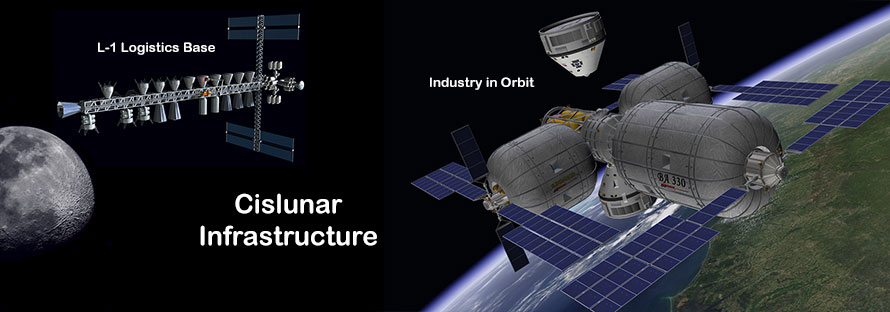 Image: [email protected] (left); Bigelow Aerospace/Boeing (right)
Image: [email protected] (left); Bigelow Aerospace/Boeing (right)
- Roadmap Table of Contents
- Part 1: General Milestones
- Part 2: Utilization and Development of Cislunar Space (this page)
- Part 3: To the Moon
- Part 4: To Mars
- Part 5: Asteroid Mining and Orbital Space Settlements
- Part 6: Additional Expansion and Greater Sustainability of Human Civilization
MILESTONE 13. Use of Space Technology and Resources on and for Earth
Space technologies, techniques and resources used widely and benefiting all on Earth.
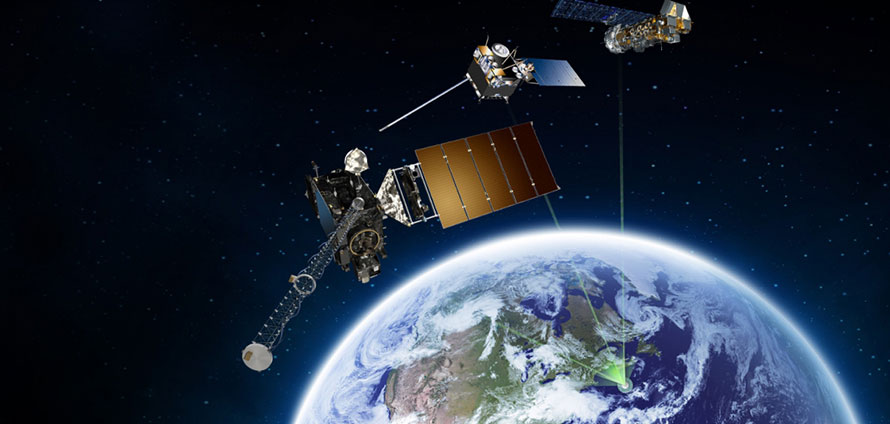 Humanity already benefits greatly from satellites such as the GOES weather satellites and COSPAS-SARSAT search and rescue satellites. Image: NOAA
Humanity already benefits greatly from satellites such as the GOES weather satellites and COSPAS-SARSAT search and rescue satellites. Image: NOAA
DESCRIPTION
The technologies and techniques developed for space settlement will not be limited to space settlements. Rather, as has always been the case, both directly and indirectly they will provide widespread benefits to Earth economies and lifestyles, as well as providing humans with a substantially enhanced ability to protect this planet from the impacts of comets and asteroids.
Some benefits will be realized almost immediately. Others will materialize over longer periods of time.
COMPONENTS (list of benefits)
Anticipated benefits from continued investment in space activities include:
Satellites for Communication. As space platforms increase in size, power, capability and numbers, existing public and private applications (such as direct-to-user-from-orbit TV, radio and data) will be augmented by more and increasingly sophisticated communications services.
Satellites for Global Positioning, Navigation and Timing. The establishment of such resources in space has already revolutionized life on Earth, as entire economies have begun to blossom around location-based services; these uses will proliferate.
Satellites for Remote Sensing. Improved use of space-borne sensors, in orbit or on the Moon, will increasingly be used for such purposes as: better weather monitoring and prediction; locating buried mineral deposits, water, and archaeological sites; tracking crop, agricultural, freshwater, and sea conditions; understanding geological conditions; and, eventually, detecting imminent earthquakes.
Commercial Use of the Space Environment. New products and knowledge will come from orbital research and orbital manufacturing facilities utilizing the vacuum and weightlessness available only in space. Production of unique pharmaceutical and biological materials in space has been demonstrated by several companies already.
Biomedical Knowledge from the Space Environment. Observations and experiments in weightlessness have provided crucial medical insights and breakthroughs, as well as revolutions in medical monitoring. Continued breakthroughs are to be expected, especially with respect to the conditions of human aging.
Ecology. People living in space and on other worlds will need to conserve and recycle resources to a greater extent than we do on Earth. The technologies and system improvements developed should have widespread applicability to living on Earth.
Agriculture. Space settlements will help drive the development of super-efficient, super-productive agricultural methods that can applied worldwide on Earth to ease hunger and increase the local production of food in urban areas.
“Spin-offs.” What is designed for space application will challenge and inspire thousands of young minds and will find thousands of new applications on Earth. That has always been the case with investment in space. After building spacecraft, scientists and engineers looked at the thousands of specialized small parts they created, that would not have existed but for the focused goal of space exploration (and the need to preserve priceless human cargo), and then found new on-Earth uses for them. In that process they created dozens of new industries and thousands of new jobs on Earth. Those benefits were in addition to benefits in the space industry itself and in addition to the ordinary multiplied effects of any government or industry spending. Similar benefits will continue to arise from future space development.
Extra-Terrestrial Raw Materials. The Moon and the asteroids contain metals and other materials that are rare on Earth, e.g. platinum. As space technologies are developed and the human presence increases beyond Earth orbit, transportation costs will come down and allow the harvesting of these resources and their return to Earth, or their use in space. Starting in 2012, asteroid mining companies have been founded and various countries have shown real interest in the concept.
Power from Orbit. Building a system of solar power satellites in Geosynchronous Earth Orbit can supply clean power to the whole world. Space solar power is covered in more detail in Milestone 17
Sunlight from Orbit. It may be possible to use giant mirrors in orbit to, for example, increase the food supply and/or provide illumination in dark areas.
MILESTONE 14. An Integrated Cislunar Space Transportation and Logistics System
Infrastructure and transportation systems providing regular movement of people, cargo and propellant among locations in cislunar space.
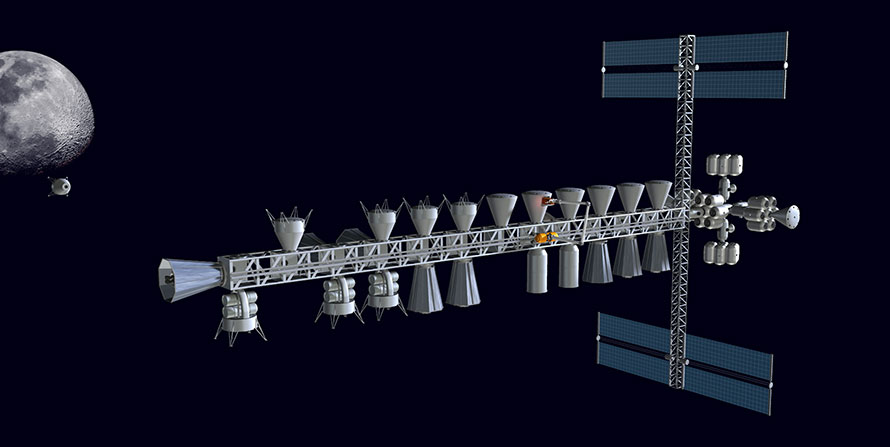 Logistics base at L1 with habitat modules (right) and multiple docking ports for vehicles and propellant depots. Image: [email protected]
Logistics base at L1 with habitat modules (right) and multiple docking ports for vehicles and propellant depots. Image: [email protected]
DESCRIPTION
In addition to Earth-to-orbit launch systems, the creation of transportation systems and infrastructure in “cislunar space,” i.e., the space between the Earth and the Moon, resulting in regular commerce in cislunar space. Cislunar space is considered to include all space near and within the Moon’s orbit, including low Earth orbit, any lunar orbits, the lunar surface and the five Earth-Moon Lagrangian points.
COMPONENTS
- Reusable space vehicles carrying people, cargo and propellant between various locations in cislunar space.
- In-space logistics bases located in lunar orbit, at the gravitationally balanced Earth-Moon L-1 or L-2 LaGrange Points, or other locations for transferring and storing propellant and cargo.
- Crew habitats attached to the logistics bases for either permanent bases or as temporary refuges while en route to other destinations.
BARRIERS
- Continued reliance on and support for expendable crew-carrying spacecraft.
- Little attention paid to logistics operations in space in support of human operations.
- Little focus or progress on propellant depots in space and reusable in-space vehicles.
BACKGROUND
As with sustainable Earth-to-orbit launch costs, primary keys to the development of cislunar space will be both reducing the cost of cislunar transportation and infrastructure to affordable levels and having enough of a lunar presence — i.e., enough people and enough cargo traversing cislunar space to reasonably amortize or justify the costs. To be significant enough, that lunar presence will almost certainly involve lunar surface operations and probably a permanent lunar presence, but a regular supply of tourists and scientists journeying just to lunar orbit and back may be a sufficient catalyst. The Moon probably has substantial water reserves in the surface deposits of cryogenic volatiles at its poles. Some of this water could be used to create rocket fuel for base operations and refueling in space.
Even if cislunar infrastructures were initially sponsored or run by governments, cislunar operations and on-board personnel increasingly may come from an ever more skilled private sector.
The transportation systems and infrastructure developed for cislunar operations, especially if integrated with each other, will prove applicable to other in-space operations anywhere in the solar system and can provide material support, such as propellant, for such operations.
 Logistics base and propellant depot at L2. Image: [email protected]
Logistics base and propellant depot at L2. Image: [email protected]
COMPLETION
This milestone can be considered achieved when regularly scheduled transfers of crew, cargo or propellant occur between three or more points in cislunar space.
MILESTONE 15. Robust Space Infrastructure for Human and Robotic Operations
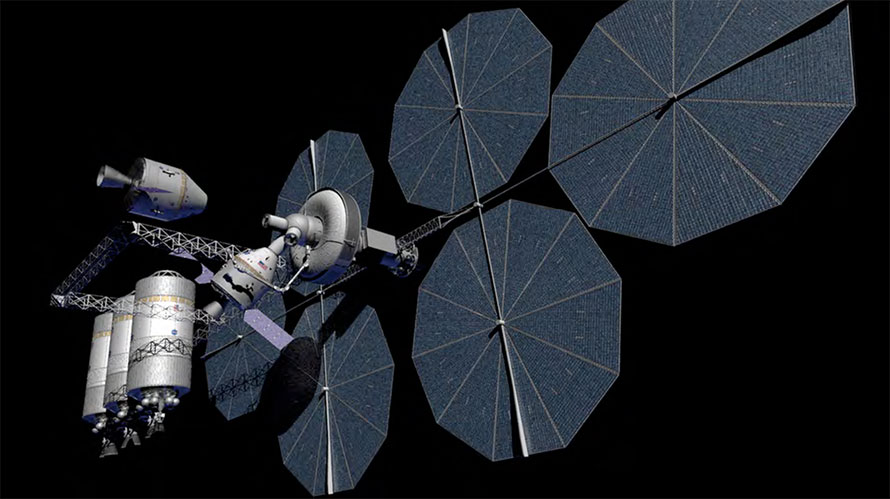 Obital propellant depot. Image: NASA
Obital propellant depot. Image: NASA
DESCRIPTION
Robust space infrastructure includes not only crew habitats and the life support and power needed to operate them, but also the equipment that gives a space facility or base the ability to support what the crew is doing. This includes science, spacecraft and logistics operations, support for construction of additional bases in space and on the Moon, Mars and asteroids. Space offers some major challenges for the operation and use of electronics, computers and communications and data transmission systems, but it also offers some major opportunities. Improvements are needed in a variety of areas specific to space applications.
COMPONENTS (types of infrastructure)
Infrastructure to support extended and cost effective human operations in space requires the design, deployment and operational use of components including:
- Reusable spacecraft (such as space tugs) that are operated and refueled in space.
- Propellant depots that will allow spacecraft to be reused and refueled in space and will support such robust activities.
- A cryocooler, sunshade and propellant insulation system that can achieve Zero Boil Off (ZBO) conditions for large cryogenic propellant depots.
- Automated and teleoperated robotic systems for construction, operations (including logistics), and maintenance of infrastructure and habitats in space, on asteroids, and on planetary surfaces.
- Power transfer via wireless power transmission from one space location to another.
- High bandwidth interplanetary communications systems.
BARRIERS
- Current lack of large, proven cryo-cooler systems for cryogenic propellant depots in microgravity.
- Current lack of proven technology to transfer cryogenic liquids between non-accelerating and non-rotating objects in space.
- Lack of software needed to safely operate external robotic systems in a manner similar to assembly line robots.
- Lack of sophisticated telepresence systems to allow direct human operation of external robots as needed for construction and logistics.
COMPLETION
This milestone can be considered achieved when a logistics base demonstrates the ability to dock several pressurized and non-pressurized space vehicles, to move cargo from one vehicle to another with a robot, and to store sufficient cryogenic propellants to enable the operation of space transport vehicles.
MILESTONE 16. Development of the first ELEO settlement
A small (about 100 m diameter), rotating habitat for permanent residents, providing about 1g in Equatorial Low Earth Orbit (ELEO) below about 500 km.

ELEO space settlement Kalpana 2. Image: Bryan Versteeg, spacehabs.com
BACKGROUND
A rotating settlement (for example, with a diameter of about 100 meters and a mass of about 8500 tons and housing about 500 people) could evolve from larger space stations or space hotels. If located in Equatorial Low Earth Orbit (ELEO), such settlements would not need radiation shielding because they would be protected from radiation by the Earth itself and the Earth’s magnetic field and would also avoid the higher radiation environment of the South Atlantic Anomaly that affects non-equatorial orbits. With radiation shielding not being needed, the mass of such settlements can be drastically reduced compared with orbital settlements located elsewhere in space. Combined with proximity to Earth this lowers cost and simplifies both logistics and integration with Earth’s economy. Therefore it seems feasible for all the building and resupply materials to be launched from Earth with a reasonable number of launches using projected future launchers. Precautions to avoid uncontrolled de-orbiting would be needed.
COMPONENTS
- Habitat intended for long-term residency.
- Transportation system to equatorial LEO.
BARRIERS
- Construction technology.
- Life support technology.
- Economic return.
- LEO debris.
COMPLETION
This milestone can be considered completed when an ELEO settlement is in regular operation.
MILESTONE 17. Space Solar Power System (SSP)
Establishment of an operational space-based solar power system harvesting solar energy in space and transmitting that energy to markets on Earth.
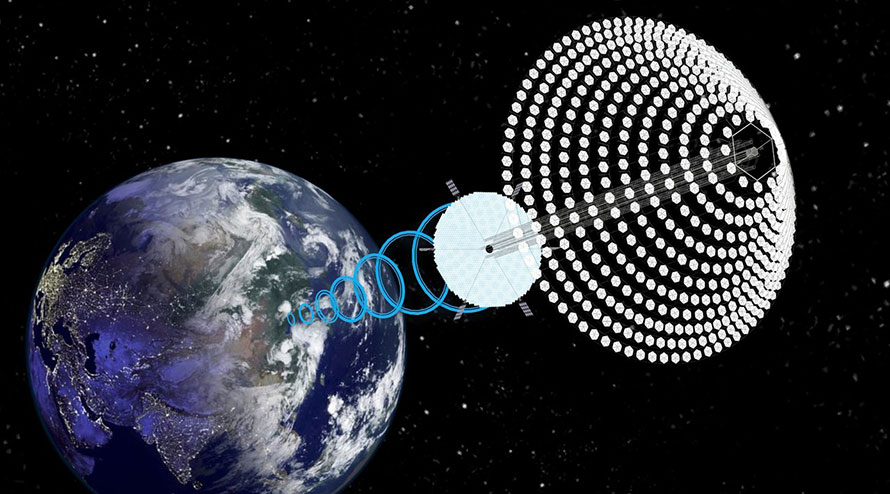 SPS Alpha. Image: John Mankins, Mankins Space Technology
SPS Alpha. Image: John Mankins, Mankins Space Technology
DESCRIPTION
Space solar power (SSP) can potentially supply a majority of the electrical needs of our planet. SSP would transmit from orbit energy from the Sun that promises to be clean, reliable and affordable. Most significantly, it would be renewable and inexhaustible.
Many of the world’s greatest problems will be greatly alleviated by accessible energy, cheap energy, or both, which can be provided by SSP. Unlike Earth-based solar power, SSP can provide almost continuous baseload as well as peak load power to replace fossil fuels. It can light and heat homes, power factories, be used for farming, for transportation, for desalination of seawater, and to provide energy in remote areas.
SSP can reduce or eliminate the need to burn fossil and nuclear fuels to generate baseload electricity. Baseload use alone currently represents about one-third of all the world’s energy demands. The capacity of SSP is so large that it should have an immense effect in reducing production of greenhouse gases and their effect on global climate.
As an initial system is augmented and improved, increasing percentages of terrestrial baseload power may be supplied from space. Even before an SSP system is completed, the realization of the pending availability of so much energy could promote world peace by substantially reducing the need for nations to compete for control of fossil fuels.
A major economic and practical advantage of SSP for baseload power utilities is that it requires almost zero energy storage, because sunlight is continuously available in space in a geostationary or geosynchronous Earth orbit (GEO or GSO). SSP platforms located in GEO could provide power to receivers on Earth more than 99.5% of the time. Ground based intermittent alternatives such as solar and wind cannot be used directly for baseload power (the minimum amount of electrical power needed during any 24-hour period), since that would require massive amounts of expensive energy storage. Large amounts of the solar and wind energy currently produced is being wasted when there is an excess of production, due to a lack of energy storage facilities. Since SSP is not intermittent, it can be used directly as baseload power, with only minimal energy storage (during periods when each platform is briefly in Earth’s shadow) and therefore does not require significant local storage. Baseload power is used at a relatively constant level, and accounts for about two-thirds of the total amount of electrical energy needed globally. By avoiding expensive storage technologies, SSP is projected to be much cheaper to produce for baseload power than clean ground based energy alternatives.
An SSP system would primarily be used to provide continuous baseload power, notwithstanding night or weather conditions, but some of the power can be used for intermittent or emergency use as needed, partly due to its ability to be redirected from one receiver to another in less than a few seconds.
Multiple locations, even isolated settlements, could increasingly be served by SSP – reducing the need for expensive, delicate, and politically sensitive long-distance re-transmission networks between power plants and the places of end use. SSP would also greatly reduce the need for fossil fuel delivery systems (such as pipelines, tanker ships, trains and trucks).
Space solar power for baseload power markets should be much more economical in its use of building materials and efficient in its use of land area than ground solar or hydroelectric power plants. For example, the 3-Gorges dam project in China required the inundation of over 100 square miles of valuable farmland to produce on average 10 GW of electrical power. A similar 10 GW delivered by SSP would require about 36 square miles – and the land underneath the SSP receiver could be simultaneously used for agriculture or other purposes (unlike the land at the bottom of a reservoir).
As stated above, an SSP system to deliver 10 Gigawatts of baseload power at an average of 100 Watts per square meter to the rectenna would cover a ground area of about 36 square miles. In comparison, 10 GW of baseload power delivered by ground solar power would require a solar array covering about 360 square miles, after accounting for nighttime, seasonal variations in solar intensity, spacing of the solar collectors, and the effects of clouds and other weather conditions. This is 10 times as much area as the SSP requirement.
Note that ground based solar power for distributed and intermittent use can be deployed in a wide variety of locations – such as rooftops – that would otherwise produce no power at all; it is for baseload power that SSP has an advantage. SSP also releases less heat at the Earth’s surface per kilowatt of useful electricity delivered than any other power generating system except wind and hydroelectric. It also uses far less raw material in its ground and in-space construction than ground based solar power and probably most other energy sources.
Moreover, SSP has the potential to be transformational for a wide range of missions and markets in space. As of 2017 the cost of electricity in space (for example at the International Space Station) is approximately $50 to $100 per kilowatt-hour, as opposed to a retail price of about 10¢-25¢ in most markets in North America. The development of SSP, with costs of electricity competitive within terrestrial markets (e.g., less than 5¢ to 15¢ per kilowatt-hour) would radically transform prospects for a wide range of in-space markets, including space resources development, manufacturing in space, space settlement and others.
The scientific feasibility of SSP has been established, and the search is underway for a consensus as to the best designs and needed infrastructure.
COMPONENTS (items needed)
- Valid business case.
- Economical surface-to-GEO transport.
- Effective design for, and development and construction of, the space component (the solar power satellite).
- Effective design for, and development and construction of, the ground component (the receiving antenna and related systems).
BARRIERS
- Opposition to and misconceptions about wireless power transmission (WPT), which is used to get space solar power from space to the ground.
- Lack of consensus that space based solar power can be more economical than alternate ground-based electrical power.
- Insufficiently reduced launch costs.
- Lack of a detailed, economically buildable design.
- Lack of agreement on the choice of microwave frequencies to use for power transmission.
- Concern that the system could be used for powering weapons.
COMPLETION
This milestone can be considered achieved when SSP systems have become operational in multiple locations, with many more in the construction pipeline, and a consensus has been reached that SSP needs to be a major component of future power supplies.
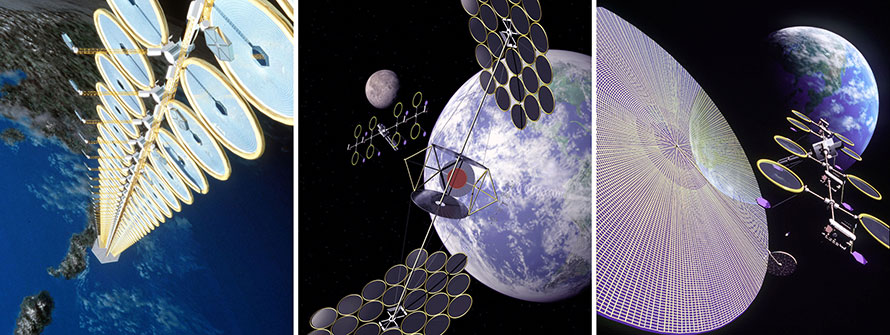 Additional space solar power concepts: Sun Tower, Integrated Symmetrical Concentrator, SERT Sandwich. Images: NASA
Additional space solar power concepts: Sun Tower, Integrated Symmetrical Concentrator, SERT Sandwich. Images: NASA






